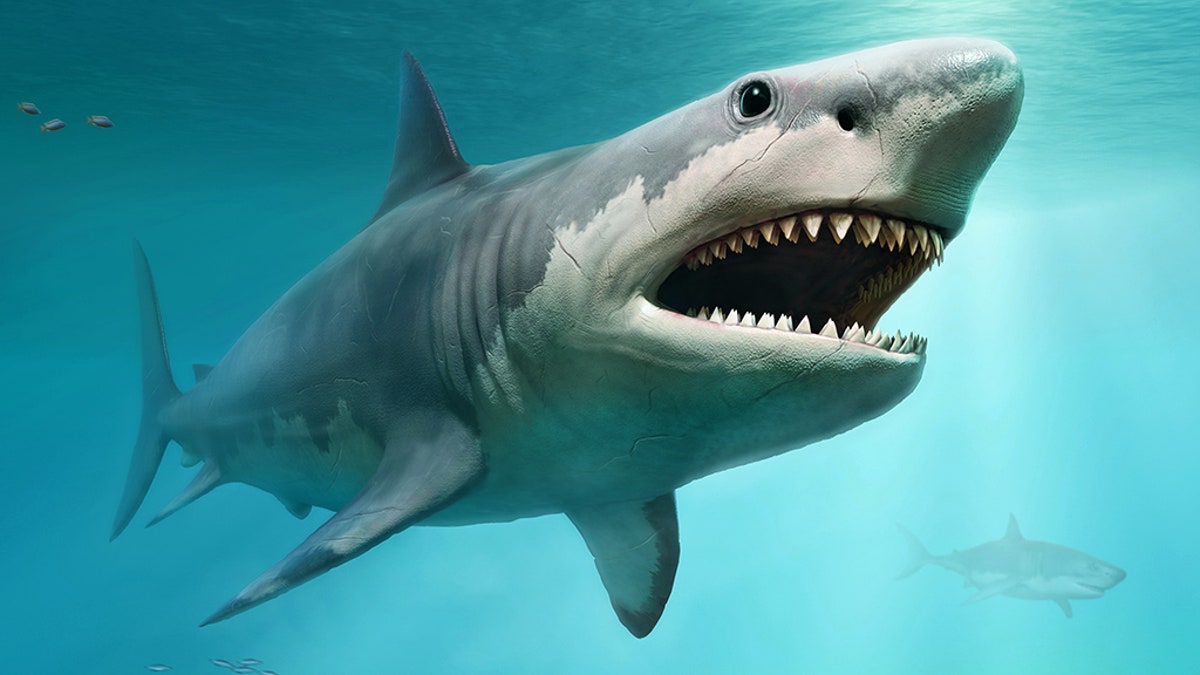
Megalodon from prehistoric times scene 3D illustration (Credit: iStock) (This content is subject to copyright.)
The megalodon, which went extinct millions of years ago, was the largest shark ever documented and one of the largest fish on record. The scientific name, Carcharocles megalodon, means "giant tooth." And for good reason: Its massive teeth give scientists major clues about what the creature was like and when it died off.
When the megalodon went extinct
While a 2018 popular movie, "The Meg," pits modern humans against the beast, more than likely, the megalodon died out before humans evolved. It is difficult to pinpoint the exact date that the megalodon went extinct, because the fossil record is incomplete.
In 2014, a research group at the University of Zurich studied megalodon fossils using a technique called optimal linear estimation, to determine their age. Their research, published in the journal PLOS ONE, found that most of the fossils date back to the middle Miocene epoch to the Pliocene epoch (15.9 million to 2.6 million years ago). All signs of the creature's existence ended 2.6 million years ago in the current fossil record, the authors wrote. For comparison, our earliest Homo sapiens ancestors emerged only 2.5 million years ago, during the Pleistocene epoch, according to the University of California Museum of Paleontology.
A very small portion of the Zurich study's data — 6 out of 10,000 simulations — showed a 1 percent chance that these giant sharks could still be alive. That chance seems pretty slim, and the researchers wrote in the study that they rejected "popular claims of present-day survival of C. megalodon."
Since there has been no evidence of the monster, including fossils that are any newer than 2.6 million years ago, the majority of scientists believe that megalodons are extinct.
Size
The megalodon was a gigantic creature, but maybe not as big as you think. There are a lot of arguments in the scientific community about the animal's actual size. Going solely by the size of the teeth, some believe that the fish could grow up to 60 feet long (18 meters), according to the Natural History Museum (NHM) in London, while others think that about 80 feet (25 m) long is more likely, according to Encyclopedia Britannica. Still others think it was much smaller. For comparison, modern great white sharks (Carcharodon carcharias) reach lengths of 20 feet (6 m), according to Animal Diversity Web. Even larger is the whale shark (Rhincodon typus), which reaches 32 feet (9.7 m). The longest bony fish alive (sharks do not have bones; their skeletons are made of cartilage) is the giant oarfish (Regalecus glesne), which has been known to reach up to 36 feet (11 m), according to the Florida Museum of Natural History. [Related: Oarfish: Photos of World's Longest Bony Fish]
"Original calculations greatly overestimated the size of megalodon," William Paterson University Professor of environmental science, Marty Becker, a paleontologist who specializes in shark research, told Live Science. "This is in part related to the fact that the megalodon fossil record is dominated almost exclusively by teeth. Current calculations indicate that megalodon may have achieved lengths up to 10 meters [around 33 feet] and nothing like what is currently featured in the summer 2018 movie 'The Meg.'"
The largest megalodon tooth measures around 7 inches (17.8 centimeters) in length, which is almost three times longer than those of great white sharks. That giant size led ancient peoples to theorize about the creatures' origins. For example, early discoveries of megalodon teeth in western Europe were thought to be the petrified tongues of ancient serpents. People called them 'tongue stones.'
The teeth are found all over the world in great quantities. "Teeth of megalodon are known to have a global occurrence and are prized among fossil collectors for their assorted colors, serrated edges and large size when compared to other fossil and modern shark teeth," said Becker. "Availability on the internet marketplace has devalued earlier fossil collections of megalodon teeth as investments."
Habitat
Like the dinosaurs, the megalodon liked warmth. During its time, it hunted in the warm, shallow seas that covered much of the planet. Megalodon teeth have been found on every continent except Antarctica. Megalodon may have gone extinct when these seas dried up, the ice age began and water was locked up at the poles, according to Discovery. Megalodon either starved or was frozen into extinction.
Diet
The megalodon was a top-of-the-food-chain predator. It fed on other big marine mammals, like whales and dolphins. It may have even eaten other sharks, according to Discovery.
Researchers think the megalodon would first attack the flipper and tails of the mammals to prevent them from swimming away, then go in for the kill, according to the BBC. The megalodon's 276 serrated teeth were the perfect tool for ripping flesh.
These sharks also had a ferocious bite. While humans have been measured to have a bite force of around 1,317 newtons, researchers have estimated that the megalodon had a bite of between 108,514 and 182,201 newtons, according to the NHM.
"Megalodon co-evolved with whales as a principal food source," Becker said. "As mammals, whales had the ability to thermoregulate and migrate toward colder waters of the poles. While the exact thermoregulatory capabilities are a topic of current study, inability to hunt whales in colder water is believed to be one of the leading causes of megalodon extinction."



















